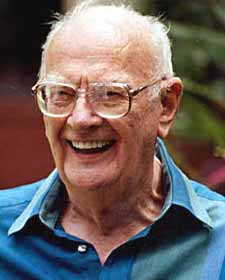Arthur C. Clarke
- Birthdate
- 1917/12/16
- Birthplace
- Somerset, England
- Death date
- 2008/03/19
- Fields of study
- Physics, Science fiction
Biography
Science fiction writer and space visionary Arthur Charles Clarke was born on 16 December 1917 in Somerset, England to Charles and Nora Clarke and was the eldest of four children. Clarke became interested in science at an early age and by age 13 had already constructed his first telescope.
While in school Clarke began to read and write “fantastic” stories that appeared in magazines like Astounding Stories. He also read the work of science fiction writers such as Jules Verne and H. G. Wells. In 1934, he joined the British Interplanetary Society, which is devoted to supporting and promoting the exploration of outer space. After completing school in 1936 he moved to London. In 1938 he moved into a flat near the British Museum with fellow science fiction writer William F. Temple and their home became the headquarters of the British Interplanetary Society.
Clarke served in the Royal Air Force as a radar instructor and technician from 1941-1946, but continued to write science fiction. In 1945 he wrote the influential article “Extra-Terrestrial Relays” for the magazine Wireless World. The article predicted a satellite communications system that would relay radio and television signals around the world. His speculations concerning satellites in geostationary orbits were realized twenty-five years later and brought him numerous awards, including the 1982 Marconi International Fellowship.
After the war, Clarke attended King’s College, London where he received a Bachelors of Science with honors in physics and mathematics in 1948. Also in 1948, Clarke’s first novel Against the Fall of Night was published. From 1949 to 1951 he was an assistant editor for Physics Abstracts, published by the Institute of Electrical Engineering, which allowed him to peruse all of the world’s leading scientific journals.
The year 1953 proved momentous for Clarke in at least two ways. He published Childhood’s End, a dark novel many consider to be his best. In it, an alien occupation of earth results in humankind’s self-destruction for its own transcendental good. He also married American Marilyn Mayfield, but they were divorced by December. This brief union gave rise to Clarke’s famous quote: “The marriage was incompatible from the beginning. It was sufficient proof that I wasn’t the marrying type, although I think everybody should marry once.”
Clarke began a long interest in undersea exploration in 1954 when he dove on the Great Barrier Reef in Australia. He followed this up with a diving trip to Ceylon (now Sri Lanka) in 1955. His passion for diving had as much to do with the ocean as with his grand passion—space. He said that he was drawn to diving as “a cheap and simple way of imitating one of the most magical aspects of spaceflight—weightlessness.”
Clarke was a member of the IEEE Sri Lanka Section.
In 1964 Clarke began his collaboration with filmmaker Stanley Kubrik on a science fiction movie script based on his 1948 short story “The Sentinel.” The novel and Oscar-nominated script of 2001: A Space Odyssey made Clarke world-famous. His newfound notoriety led to his co-broadcasting the Apollo 11, 12, and 15 missions to the Moon for CBS. His fame only increased when he won all three of the major science fiction writing awards (Hugo, Nebula, and John W. Campbell Memorial Award) in 1973 for his novel Rendezvous with Rama.
In 1986 Clarke was diagnosed as suffering from Amyotrophic Lateral Sclerosism, more commonly known as “Lou Gehrig’s disease,” but a second opinion in 1988 rediagnosed him with post-polio syndrome. While not terminal, the disease has confined Clarke to a wheelchair. In 1989 Clarke received a CBE (Commander of the British Empire) from the Queen of England and was knighted in 1998 for his services to literature. In 1994 he was nominated for the Nobel Peace Prize. Clarke died in March 2008.

